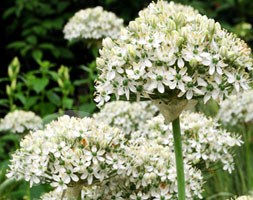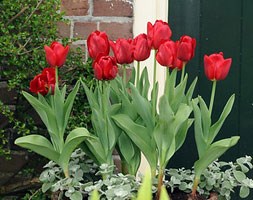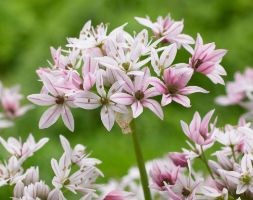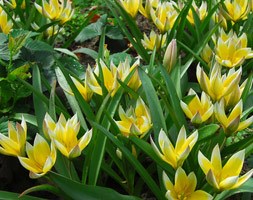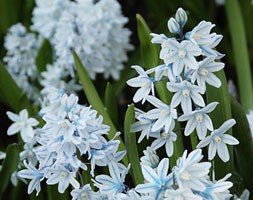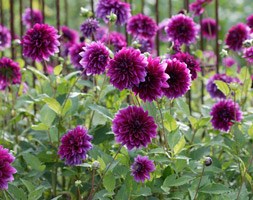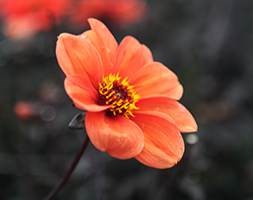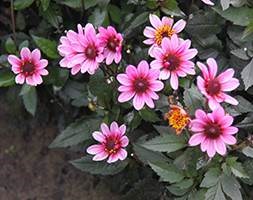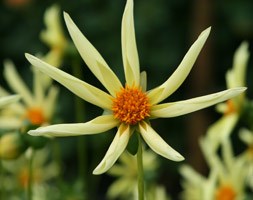Price reductions at Crocus
by Sarah - November 11th, 2013.Filed under: Crocus, Price Reductions.
Crocus has cut the price of loads of products today
Allium nigrum (ornamental onion bulbs) was £2.99 now £1.99
Position: full sun Soil: fertile, well-drained soil Rate of growth: fast-growing Flowering period: June Flower colour: white Other features: grey-green leaves Hardiness: fully hardy Bulb size: 10/12 The grey-green leaves of this ornamental onion generally have started to die back when the flowers emerge in early summer. These sit on tall, sturdy stems forming flattish clusters that create a striking silhouette. Each creamy-white to pale lavender flower has a pronounced ovary at its heart, which looks a little like a green pearl, nestled in the centre. Very pretty – and in big demand after its appearance in Cleve Wests garden at Chelsea in 2012. Garden care: Plant bulbs 15cm deep and 15cm apart to enjoy the full effect of the flowers. Avoid excessive mositure from late summer when they become dormant. Over-large clumps can be lifted and divided in autumn or spring.
Tulipa ‘Princesse Charmante’ (greigii tulip bulbs) was £2.49 now £1.99
Position: full sun Soil: fertile, well-drained soil Rate of growth: average Flowering period: March to April Flower colour: orange-red Other features: excellent cut-flowers Hardiness: fully hardy Bulb size: 11/12 Like many other members of the greigii group, the leaves of this tulip are attractively mottled with maroon. The simmering red and orange flowers appear in March or April, providing a bold blast of seasonal colour for the front of the border, rockery or patio pot. Relatively short as far as tulips go, their flowers nonetheless are large in comparison and very showy. Garden care: In September to December plant bulbs 15-20cm deep and 10-15cm apart in fertile, well-drained soil. Alternatively, allow 7-9 bulbs per 30cm sq. After flowering dead-head and apply a balanced liquid fertiliser each week for the first month. Once the foliage has died down naturally lift the bulbs and store in a cool greenhouse.
Allium ‘Cameleon’ (ornamental onion) was £3.99 now £2.49
Position: full sun Soil: fertile, well-drained soil Rate of growth: average Flowering period: June Hardiness: fully hardy Bulb size:4+ Initially dusky rose pink, the early summer flowers fade to white as they mature, but retain their pink veining. Good for naturalising in swathes or clusters, this relatively compact form will also put on a fresh display in patio pots or windowboxes. Blend it with rich pink shades as well as lilacs and soft blues for best effect. Garden care: Plant bulbs 10cm deep and 10cm apart to enjoy the full effect of the flowers. Avoid excessive soil moisture, and split and divide large clumps in autumn or spring.
Tulipa tarda (species tulip bulbs) was £3.99 now £2.99
Position: full sun Soil: fertile, well-drained soil Rate of growth: average Flowering period: March – April Flower colour: white-yellow Other features: all parts of the plant may cause a mild stomach upset if ingested; contact with any parts of the plant may aggravate skin allergies Hardiness: fully hardy Bulb size:7/8 Shiny, lance-shaped green leaves form loose clumps, which in early to mid-spring, are crowned with white-tipped yellow flowers, often with a reverse that is flushed with red and green. Happiest in richer soils, its compact habit makes it ideal for pots. This tulip is one of the few that do not need to be lifted each year and if planted in the ground, it will spread to form good-sized clumps. Garden care: In November or December plant bulbs 10-15cm deep in fertile, well-drained soil. After flowering dead-head and apply a balanced liquid fertiliser each week for the first month.
Puschkinia scilloides var. libanotica (Russian snowdrop bulbs) was £3.99 now £2.99
Position: full sun or partial shade Soil: most well-drained soils Rate of growth: average Flowering period: March to April Hardiness: fully hardy At roughly the same time in spring, the strappy upright(ish) foliage appears, almost seeming to stand guard at each side of the emerging flowerspike. This spike carries up to 10 near-white flowers, which often have a faint blue stripe down the length of each petal. It is very pretty when intermingled with Cyclamen or Fritillaria (the snake’s head type), but avoid overcrowding as they like their space, and will naturalise areas under trees and shrubs if left undisturbed. They do well in pots too. Garden care: Plant 5 – 10cm deep and a similar distance apart in autumn. Leave undosturbed and they will form good-sized clumps.
Dahlia ‘Thomas A. Edison’ (dahlia) was £4.99 now £3.49
Position: full sun Soil: fertile, humus-rich soil Rate of growth: average Flowering period: July to September Hardiness: half hardy (will need winter protection) We wanted this decorative dahlia in our collection as its flower colour is so easy to mix with a wide range of other shades. The many-petalled, medium-sized blooms are crammed with magenta pink petals, which tend to be a touch paler towards theit outer edges. They are also excellent for cutting, which will encourage more to form. Garden care: Dahlia tubers can be planted outside after frost, or started off in pots under glass in late winter to early spring. Plant them horizontally approximately 12cm deep, making sure the ‘eyes’ are uppermost. Allow enough room between each tuber so the plants can grow and spread to their full size without being over-crowded. While in growth, provide a high-nitrogen liquid feed each week in June, then a high-potash fertiliser each week from July to September. Stake with canes or brushwood if it becomes necessary. In mild areas, leave them in situ over winter, but protect the crown with a generous layer of dry mulch. In colder areas, carefully lift and clean the tubers once the first frosts have blackened the foliage and allow them to dry naturally indoors. Then place the dry tubers in a shallow tray, just covered with slightly moist potting compost, sand or vermiculite and store in a frost-free place until planting out again.
Dahlia ‘Bishop of Oxford’ (dahlia tuber) was £3.99 now £3.49
Position: full sun Soil: fertile, humus-rich soil Rate of growth: average Flowering period: July to September Flower colour: peachy-orange Other features: excellent cut-flowers Hardiness: half hardy (may need winter protection) The soft orange flowers are held above the purple-flushed foliage on dark-coloured stems, creating a lush blend of colour that really stands out in the border. Mix it with rich orange and red, or shades of yellow for a harmonious combination. Alternativey, try it as an accent with plum and purple . Garden care: Dahlia tubers can be planted outside after frost, or started off in pots under glass in late winter to early spring. Plant them horizontally approximately 12cm deep, making sure the ‘eyes’ are uppermost. Allow enough room between each tuber so the plants can grow and spread to their full size without being over-crowded. While in growth, provide a high-nitrogen liquid feed each week in June, then a high-potash fertiliser each week from July to September. Stake with canes or brushwood if it becomes necessary. In mild areas, leave them in situ over winter, but protect the crown with a generous layer of dry mulch. In colder areas, carefully lift and clean the tubers once the first frosts have blackened the foliage and allow them to dry naturally indoors. Then place the dry tubers in a shallow tray, just covered with slightly moist potting compost, sand or vermiculite and store in a frost-free place until planting out again.
Dahlia Pretty Woman (‘Vdtg43’) (PBR) (Dark Angel Series) (dahlia tuber) was £3.99 now £3.49
Position: full sun Soil: fertile, humus-rich soil Rate of growth: average Flowering period: July to September Flower colour: orange Other features: excellent cut-flowers Hardiness: half hardy (will need winter protection) The pretty, single flowerheads consist of a row of sugar pink ‘petals’, which become a darker shade at their base. These surround a dark pink central disc, thet turns golden-yellow as it ages. The flowerheads top upright stems and contrast beautifully with the bronze-flushed foliage. Its compact habit makes it perfect for pots and the flowers are also excellent for cut arrangements. Garden care: Dahlia tubers can be planted outside after frost, or started off in pots under glass in late winter to early spring. Plant them horizontally approximately 12cm deep, making sure the ‘eyes’ are uppermost. Allow enough room between each tuber so the plants can grow and spread to their full size without being over-crowded. While in growth, provide a high-nitrogen liquid feed each week in June, then a high-potash fertiliser each week from July to September. Stake with canes or brushwood if it becomes necessary. In mild areas, leave them in situ over winter, but protect the crown with a generous layer of dry mulch. In colder areas, carefully lift and clean the tubers once the first frosts have blackened the foliage and allow them to dry naturally indoors. Then place the dry tubers in a shallow tray, just covered with slightly moist potting compost, sand or vermiculite and store in a frost-free place until planting out again.
Dahlia ‘Honka’ (dahlia tuber) was £3.99 now £3.49
Position: full sun Soil: fertile, humus-rich soil Rate of growth: average Flowering period: July to September Flower colour: yellow Hardiness: half hardy (will need winter protection) Simple, star-like, yellow flowers with a light fragrance, top sturdy stems from midsummer. Each flower is made up of eight petals, which curl inwards towards their tip, around a bright orange center. Perfect for planting in pots on the patio as the tubers must be lifted and over-wintered in a frost-free place in all but the warmest areas. Garden care: Dahlia tubers can be planted outside after frost, or started off in pots under glass in late winter to early spring. Plant them horizontally approximately 12cm deep, making sure the ‘eyes’ are uppermost. Allow enough room between each tuber so the plants can grow and spread to their full size without being over-crowded. While in growth, provide a high-nitrogen liquid feed each week in June, then a high-potash fertiliser each week from July to September. Stake with canes or brushwood if it becomes necessary. In mild areas, leave them in situ over winter, but protect the crown with a generous layer of dry mulch. In colder areas, carefully lift and clean the tubers once the first frosts have blackened the foliage and allow them to dry naturally indoors. Then place the dry tubers in a shallow tray, just covered with slightly moist potting compost, sand or vermiculite and store in a frost-free place until planting out again.







